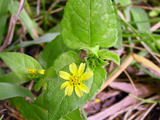Native Plants

Q. Who is Mr. Smarty Plants?
A: There are those who suspect Wildflower Center volunteers are the culpable and capable culprits. Yet, others think staff members play some, albeit small, role. You can torture us with your plant questions, but we will never reveal the Green Guru's secret identity.
Did you know you can access the Native Plant Information Network with your web-enabled smartphone?
Ask Mr. Smarty Plants is a free service provided by the staff and volunteers at the Lady Bird Johnson Wildflower Center.

rate this answer
Wednesday - December 12, 2012
From: Austin, TX
Region: Southwest
Topic: Groundcovers, Herbs/Forbs
Title: Replacing St. Augustine with Horse herb in Austin, TX.
Answered by: Jimmy Mills
QUESTION:
I'm considering replacing my St. Augustine grass with a Horseherb/Straggler Daisy ground cover, but I've heard that it provides a mosquito breeding habitat, especially if you allow dead leaves to decay beneath it. To minimize this, would I need to keep it well-raked in autumn? What about mowing? Thanks!ANSWER:
First, lets try to understand the difference between mosquito mating, and mosquito breeding. Mosquito breeding is dependent upon standing water where the female can lay her eggs that hatch into larvae and is an important part of the life cycle. Mating can occur about anywhere, and is not restricted to any particular type of plant. So dead decaying horse herb leaves would not constitute a mosquito breeding habitat.
Horseherb Calyptocarpus vialis (Straggler daisy) is semi-evergreen, remaining green and blooming year-round in temperate climates. It can go dormant in cold winters. It ordinarily blooms yellow March to November, has low water use, and can do well in sun, part shade or shade. It is a fast growing plant and is considered invasive by some, and has both its detractors and admirers. I’m going to provide you with two links that will give you information about this interesting plant.
Greatstems.com
NICE
From the Image Gallery
More Herbs/Forbs Questions
Manor, TX in Blackland Prairie ecoregion
June 27, 2006 - Hi, I am planning an event for my community in Shadowglen and Manor, TX so my neighbors can learn about using native plants in the landscape to create healthier habitat for wildlife and be more respon...
view the full question and answer
Native Texas Plants for SC
June 22, 2015 - I just visited your beautiful facility for the first time and loved it! I'm planning to move to Charleston, SC and would love to replicate some of the wildflower and walkway areas I saw. Would the fo...
view the full question and answer
Plants indigenous to Sedona, AZ
July 07, 2010 - I live in Sedona AZ and I want to plant indigenous plants in my garden. Is there a list of AZ native plants shrubs and trees that are indigenous to Sedona?
If there is no list that is specific f...
view the full question and answer
Need to identify hemp-like plant in Bastrop, TX.
June 09, 2014 - What is the large stalky, hemp-like plant that populates our creek bottoms and ditches here in Central Texas? It has large 5-6 in. lobed leaves, and a fibrous central stalk that gets up to 7 ft tall. ...
view the full question and answer
Plants for a property near a conservation area in MD
July 18, 2011 - Can you tell me what native plants and the type of landscaping that would be good to plant in front of a forest conservation area that is on a steep hill behind our future house? It is located in Manc...
view the full question and answer
| Support the Wildflower Center by Donating Online or Becoming a Member today. |

